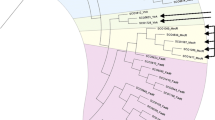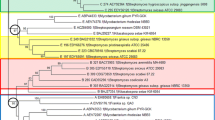Abstract
The AdpA protein from a streptomycin producer Streptomyces griseus is a founding member of the AdpA family of pleiotropic regulators, known to be ubiquitously present in streptomycetes. Functional genomic approaches revealed a huge number of AdpA targets, leading to the claim that the AdpA regulon is the largest one in bacteria. The expression of adpA is limited at the level of translation of the rare leucyl UUA codon. All known properties of AdpA regulators were discovered on a few streptomycete strains. There are open questions about the true abundance and diversity of AdpA across actinobacterial taxa (and beyond) and about the possible evolutionary forces that shape the AdpA orthologous group in Streptomyces. Here we show that, with respect to the TTA codon, streptomycete adpA is more diverse than has been previously thought, as the genes differ in presence/position of this codon. Reciprocal best hits to AdpA can be found in many actinobacterial orders, with a domain organization resembling that of the prototypical AdpA, but other configurations also exist. Diversifying positive selection was detected within the DNA-binding (AraC) domain in adpA of Streptomyces origin, most likely affecting residues enabling AdpA to recognize a degenerate operator. Sequence coding for putative glutamine amidotransferase (GATase-1) domain also shows signs of positive selection. The two-domain organization of AdpA most likely arose from a fusion of genes encoding separate GATase-1 and AraC domains. Indeed, we show that the AraC domain retains a biological function in the absence of the GATase-1 part. We suggest that acquisition of the regulatory role by TTA codon is a relatively recent event in the evolution of AdpA, which coincided with the rise of the Streptomycetales clade and, at present, is under relaxed selective constraints. Further experimental scrutiny of our findings is invited, which should provide new insights into the evolution and prospects for engineering of an AdpA-centered regulatory network.





Similar content being viewed by others
References
Akaike H (1973) Information theory and an extension of the maximum likelihood principle. In: Petrov BN, Csaki F (eds) Second international symposium on information theory. Akademiai Kiado, Budapest, pp 267–281
Aziz RK, Breitbart M, Edwards RA (2010) Transposases are the most abundant, most ubiquitous genes in nature. Nucleic Acids Res 38(13):4207–4217
Bailey TL, Boden M, Buske FA, Frith M, Grant CE, Clementi L, Ren J, Li WW, Noble WS (2009) MEME suite: tools for motif discovery and searching. Nucleic Acids Res 37(Suppl 2):202–208
Chandra G, Chater KF (2014) Developmental biology of Streptomyces from the perspective of 100 actinobacterial genome sequences. FEMS Microbiol Rev 38(3):345–379
Chater KF, Chandra G (2008) The use of the rare UUA codon to define “expression space” for genes involved in secondary metabolism, development and environmental adaptation in Streptomyces. J Microbiol 46(1):1–11
Ciccarelli FD, Doerks T, von Mering C, Creevey CJ, Snel B, Bork P (2006) Toward automatic reconstruction of a highly resolved tree of life. Science 311(5765):1283–1287
Frota CC, Papavinasasundaram KG, Davis EO, Colston MJ (2004) The AraC family transcriptional regulator Rv1931c plays a role in the virulence of Mycobacterium tuberculosis. Infect Immun 72(9):5483–5486
Fuglsang A (2005) Intragenic position of UUA codons in streptomycetes. Microbiology 151(Pt 10):3150–3152
Gabaldon T, Koonin EV (2013) Functional and evolutionary implications of gene orthology. Nat Rev Genet 14(5):360–366
Gil M, Zanetti MS, Zoller S, Anisimova M (2013) CodonPhyML: fast maximum likelihood phylogeny estimation under codon substitution models. Mol Biol Evol 30(6):1270–1280
Goldman N, Yang Z (1994) A codon-based model of nucleotide substitution for protein-coding DNA sequences. Mol Biol Evol 11:725–736
Guyet A, Benaroudj N, Proux C, Gominet M, Coppée JY, Mazodier P (2014) Identified members of the Streptomyces lividans AdpA regulon involved in differentiation and secondary metabolism. BMC Microbiol 14:81
Hackl S, Bechthold A (2015) The Gene bldA, a regulator of morphological differentiation and antibiotic production in Streptomyces. Arch Pharm 348(7):455–462
Hiard S, Maree R, Colson S, Hoskisson PA, Titgemeyer F, van Wezel GP, Joris B, Wehenkel L, Rigali S (2007) PREDetector: a new tool to identify regulatory elements in bacterial genomes. Biochem Biophys Res Commun 357(4):861–864
Higo A, Horinouchi S, Ohnishi Y (2011) Strict regulation of morphological differentiation and secondary metabolism by a positive feedback loop between two global regulators AdpA and BldA in Streptomyces griseus. Mol Microbiol 81(6):1607–1622
Higo A, Hara H, Horinouchi S, Ohnishi Y (2012) Genome-wide distribution of AdpA, a global regulator for secondary metabolism and morphological differentiation in streptomyces, revealed the extent and complexity of the AdpA regulatory network. DNA Res 19(3):259–273
Horbal L, Fedorenko V, Luzhetskyy A (2014) Novel and tightly regulated resorcinol and cumate-inducible expression systems for Streptomyces and other actinobacteria. Appl Microbiol Biotechnol 98(20):8641–8655
Horinouchi S (2007) Mining and polishing of the treasure trove in the bacterial genus streptomyces. Biosci Biotechnol Biochem 71(2):283–299
Ishikawa J, Hotta K (1999) FramePlot: a new implementation of the Frame analysis for predicting protein-coding regions in bacterial DNA with a high G+C content. FEMS Microbiol Rev 174(2):251–253
Jolley KA, Bliss CM, Bennett JS, Bratcher HB, Brehony C, Colles FM, Wimalarathna H, Harrison OB, Sheppard SK, Cody AJ, Maiden MCJ (2012) Ribosomal multilocus sequence typing: universal characterization of bacteria from domain to strain. Microbiology 158(4):1005–1015
Kass RE, Raftery AE (1995) Bayes factors. J Am Stat Assoc 90(430):773–795
Kato JY, Ohnishi Y, Horinouchi S (2005) Autorepression of AdpA of the AraC/XylS family, a key transcriptional activator in the A-factor regulatory cascade in Streptomyces griseus. J Mol Biol 350(1):12–26
Kieser T, Bibb MJ, Buttner MJ, Chater KF, Hopwood DA (2000) Practical streptomyces genetics. John Innes Foundation, Norwich
Kosakovsky Pond SL, Frost SDW (2005) Not so different after all: a comparison of methods for detecting amino acid sites under selection. Mol Biol Evol 22(5):1208–1222
Kosakovsky Pond SL, Frost SDW, Muse SV (2005) HyPhy: hypothesis testing using phylogenies. Bioinformatics 21(5):676–679
Lawlor EJ, Baylis HA, Chater KF (1987) Pleiotropic morphological and antibiotic deficiencies result from mutations in a gene encoding a tRNA-like product in Streptomyces coelicolor A3(2). Genes Dev 1(10):1305–1310
Le SQ, Gascuel O (2008) An improved general amino acid replacement matrix. Mol Biol Evol 25:1307–1320
López-García MT, Santamarta I, Liras P (2010) Morphological differentiation and clavulanic acid formation are affected in a Streptomyces clavuligerus adpA-deleted mutant. Microbiology 156(8):2354–2365
Marchler-Bauer A, Lu S, Anderson JB, Chitsaz F, Derbyshire MK, DeWeese-Scott C, Fong JH, Geer LY, Geer RC, Gonzales NR, Gwadz M, Hurwitz DI, Jackson JD, Ke Z, Lanczycki CJ, Lu F, Marchler GH, Mullokandov M, Omelchenko MV, Robertson CL, Song JS, Thanki N, Yamashita RA, Zhang D, Zhang N, Zheng C, Bryant SH (2011) CDD: a conserved domain database for the functional annotation of proteins. Nucleic Acids Res 39(Suppl 1):225–229
Moreno-Hagelsieb G, Latimer K (2008) Choosing BLAST options for better detection of orthologs as reciprocal best hits. Bioinformatics 24(3):319–324
Nguyen KT, Tenor J, Stettler H, Nguyen LT, Nguyen LD, Thompson CJ (2003) Colonial differentiation in Streptomyces coelicolor depends on translation of a specific codon within the adpA Gene. J Bacteriol 185(24):7291–7296
Nielsen R, Yang Z (1998) Likelihood models for detecting positively selected amino acid sites and applications to the HIV-1 envelope gene. Genetics 148(3):929–936
Ohnishi Y, Kameyama S, Onaka H, Horinouchi S (1999) The A-factor regulatory cascade leading to streptomycin biosynthesis in Streptomyces griseus: identification of a target gene of the A-factor receptor. Mol Microbiol 34(1):102–111
Ohnishi Y, Yamazaki H, Kato JY, Tomono A, Horinouchi S (2005) AdpA, a central transcriptional regulator in the A-factor regulatory cascade that leads to morphological development and secondary metabolism in Streptomyces griseus. Biosci Biotechnol Biochem 69(3):431–439
Ostash B, Yushchuk O, Tistechok S, Mutenko H, Horbal L, Muryn A, Dacyuk Y, Kalinowski J, Luzhetskyy A, Fedorenko V (2015) The adpA-like regulatory gene from Actinoplanes teichomyceticus: in silico analysis and heterologous expression. World J Microbiol Biotechnol 31(8):1297–1301
Pan Y, Liu G, Yang H, Tian Y, Tan H (2009) The pleiotropic regulator AdpA-L directly controls the pathway-specific activator of nikkomycin biosynthesis in Streptomyces ansochromogenes. Mol Microbiol 72(3):710–723
Pond SK, Muse SV (2005) Site-to-site variation of synonymous substitution rates. Mol Biol Evol 22(12):2375–2385
Rodrigue N, Lartillot N, Philippe H (2008) Bayesian comparisons of codon substitution models. Genetics 180(3):1579–1591
Segata N, Börnigen D, Morgan XC, Huttenhower C (2013) PhyloPhlAn is a new method for improved phylogenetic and taxonomic placement of microbes. Nat Commun 4:2304
Sen A, Thakur S, Bothra AK, Sur S, Tisa LS (2012) Identification of TTA codon containing genes in Frankia and exploration of the role of tRNA in regulating these genes. Arch Microbiol 194(1):35–45
Šetinová D, Šmídová K, Pohl P, Musić I, Bobek J (2018) RNase III-binding-mRNAs revealed novel complementary transcripts in Streptomyces. Front Microbiol 8:2693
Sharp PM, Averof M, Lloyd AT, Matassi G, Peden JF (1995) DNA sequence evolution: the sounds of silence. Philos Trans R Soc Lond B 349(1329):241–247
Suzuki Y, Gojobori T (1999) A method for detecting positive selection at single amino acid sites. Mol Biol Evol 16(10):1315–1328
Szalkowski AM (2012) Fast and robust multiple sequence alignment with phylogeny-aware gap placement. BMC Bioinform 13:129
Takano E, Tao M, Long F, Bibb MJ, Wang L, Li W, Buttner MJ, Bibb MJ, Deng ZX, Chater KF (2003) A rare leucine codon in adpA is implicated in the morphological defect of bldA mutants of Streptomyces coelicolor. Mol Microbiol 50(2):475–486
Tanabe M, Kanehisa M (2012) Using the KEGG database resource. Curr Protoc Bioinform 38:1.12:1.12.1–1.12.43
Ventura M, Canchaya C, Tauch A, Chandra G, Fitzgerald GF, Chater KF, van Sinderen D (2007) Genomics of Actinobacteria: tracing the evolutionary history of an ancient phylum. Microbiol Mol Biol Rev 71(3):495–548
Wattam AR, Abraham D, Dalay O, Disz TL, Driscoll T, Gabbard JL, Gillespie JJ, Gough R, Hix D, Kenyon R, Machi D, Mao C, Nordberg EK, Olson R, Overbeek R, Pusch GD, Shukla M, Schulman J, Stevens RL, Sullivan DE, Vonstein V, Warren A, Will R, Wilson MJ, Yoo HS, Zhang C, Zhang Y, Sobral BW (2014) PATRIC, the bacterial bioinformatics database and analysis resource. Nucleic Acids Res 42(D1):581–591
Wolański M, Donczew R, Kois-Ostrowska A, Masiewicz P, Jakimowicz D, Zakrzewska-Czerwińska J (2011) The level of AdpA directly affects expression of developmental genes in Streptomyces coelicolor. J Bacteriol 193(22):6358–6365
Wolański M, Jakimowicz D, Zakrzewska-Czerwińska J (2014) Fifty years after the replicon hypothesis: cell-specific master regulators as new players in chromosome replication control. J Bacteriol 196(16):2901–2911
Xu J, Zhang J, Zhuo J, Li Y, Tian Y, Tan H (2017) Activation and molecular mechanism of a cryptic oviedomycin biosynthetic gene cluster via the disruption of a global regulatory gene adpA in Streptomyces ansochromogenes. J Biol Chem. https://doi.org/10.1074/jbc.M117.809145
Yamazaki H, Tomono A, Ohnishi Y, Horinouchi S (2004) DNA-binding specificity of AdpA, a transcriptional activator in the A-factor regulatory cascade in Streptomyces griseus. Mol Microbiol 53(2):555–572
Yang Z, Bielawski JP (2000) Statistical methods for detecting molecular adaptation. Trends Ecol Evol 15(12):496–503
Yang Z, Nielsen R, Goldman N, Pedersen AM (2000) Codon-substitution models for heterogeneous selection pressure at amino acid sites. Genetics 155(1):431–449
Yao MD, Ohtsuka J, Nagata K, Miyazono KI, Zhi Y, Ohnishi Y, Tanokura M (2013) Complex structure of the DNA-binding domain of AdpA, the global transcription factor in Streptomyces griseus, and a target duplex DNA reveals the structural basis of its tolerant DNA sequence specificity. J Biol Chem 288(43):31019–31029
Zaburannyy N, Ostash B, Fedorenko V (2009) TTA Lynx: a web-based service for analysis of actinomycete genes containing rare TTA codon. Bioinformatics 25(18):2432–2433
Zhao J, Wen Y, Chen Z, Song Y, Li J (2007) An adpA homologue in Streptomyces avermitilis is involved in regulation of morphogenesis and melanogenesis. Chinese Sci Bull 52(5):623–630
Acknowledgements
The work was supported by grant BG-41Nr from the Ministry of Education and Science of Ukraine (to B.O.).
Author information
Authors and Affiliations
Corresponding author
Electronic supplementary material
Below is the link to the electronic supplementary material.
Rights and permissions
About this article
Cite this article
Rabyk, M., Yushchuk, O., Rokytskyy, I. et al. Genomic Insights into Evolution of AdpA Family Master Regulators of Morphological Differentiation and Secondary Metabolism in Streptomyces. J Mol Evol 86, 204–215 (2018). https://doi.org/10.1007/s00239-018-9834-z
Received:
Accepted:
Published:
Issue Date:
DOI: https://doi.org/10.1007/s00239-018-9834-z




